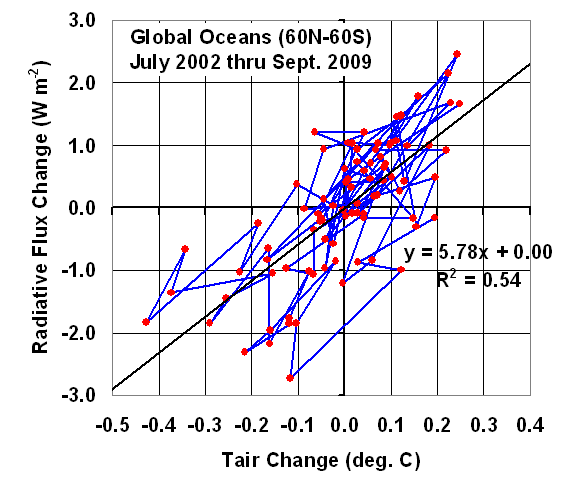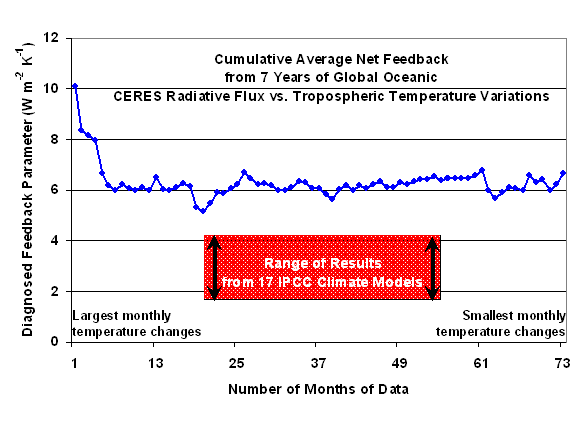Arguably the single most important scientific issue – and unresolved question – in the global warming debate is climate sensitivity. Will increasing carbon dioxide cause warming that is so small that it can be safely ignored (low climate sensitivity)? Or will it cause a global warming Armageddon (high climate sensitivity)?
The answer depends upon the net radiative feedback: the rate at which the Earth loses extra radiant energy with warming. Climate sensitivity is mostly determined by changes in clouds and water vapor in response to the small, direct warming influence from (for instance) increasing carbon dioxide concentrations.
The net radiative feedback can be estimated from global, satellite-based measurements of natural climate variations in (1) Earth’s radiation budget, and (2) tropospheric temperatures.
These feedback estimates have been mostly constrained by the availability of the first measurement: the best calibrated radiation budget data comes from the NASA CERES instruments, with data now available for 9.5 years from the Terra satellite, and 7 years from the Aqua satellite. Both datasets now extend through September of 2009.
I’ve been slicing and dicing the data different ways, and here I will present 7 years of results for the global (60N to 60S) oceans from NASA’s Aqua satellite. The following plot shows 7 years of monthly variations in the Earth’s net radiation (reflected solar shortwave [SW] plus emitted infrared longwave [LW]) compared to similarly averaged tropospheric temperature from AMSU channel 5.

Simple linear regression yields a net feedback factor of 5.8 Watts per sq. meter per degree C. If this was the feedback operating with global warming, then it would amount to only 0.6 deg. C of human-caused warming by late in this century. (Use of sea surface temperatures instead of tropospheric temperatures yields a value of over 11).
Since we have already experienced 0.6 deg. C in the last 100 years, it would also mean that most of our current global warmth is natural, not anthropogenic.
But, as we show in our new paper (in press) in the Journal of Geophysical Research, these feedbacks can not be estimated through simple linear regression on satellite data, which will almost always result in an underestimate of the net feedback, and thus an overestimate of climate sensitivity.
Without going into the detailed justification, we have found that the most robust method for feedback estimation is to compute the month-to-month slopes (seen as the line segments in the above graph), and sort them from the largest 1-month temperature changes to the smallest (ignoring the distinction between warming and cooling).
The following plot shows, from left to right, the cumulative average line slope from the largest temperature changes to the smaller ones. This average is seen to be close to 10 for the largest month-to-month temperature changes, then settling to a value around 6 after averaging of many months together. (Note that the full period of record is not used: only monthly temperature changes greater than 0.03 deg. C were included. Also, it is mostly coincidence that the two methods give about the same value.)

A net feedback of 6 operating on the warming caused by a doubling of atmospheric CO2 late in this century would correspond to only about 0.5 deg. C of warming. This is well below the 3.0 deg. C best estimate of the IPCC, and even below the lower limit of 1.5 deg. C of warming that the IPCC claims to be 90% certain of.
How Does this Compare to the IPCC Climate Models?
In comparison, we find that none of the 17 IPCC climate models (those that have sufficient data to do the same calculations) exhibit this level of negative feedback when similar statistics are computed from output of either their 20th Century simulations, or their increasing-CO2 simulations. Those model-based values range from around 2 to a little over 4.
These results suggest that the sensitivity of the real climate system is less than that exhibited by ANY of the IPCC climate models. This will end up being a serious problem for global warming predictions. You see, while modelers claim that the models do a reasonably good job of reproducing the average behavior of the climate system, it isn’t the average behavior we are interested in. It is how the average behavior will CHANGE.
And the above results show that not one of the IPCC climate models behaves like the real climate system does when it comes to feedbacks during interannual climate variations…and feedbacks are what determine how serious manmade global warming will be.

 Home/Blog
Home/Blog



